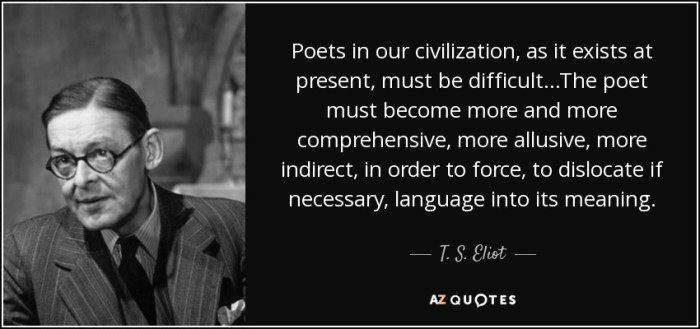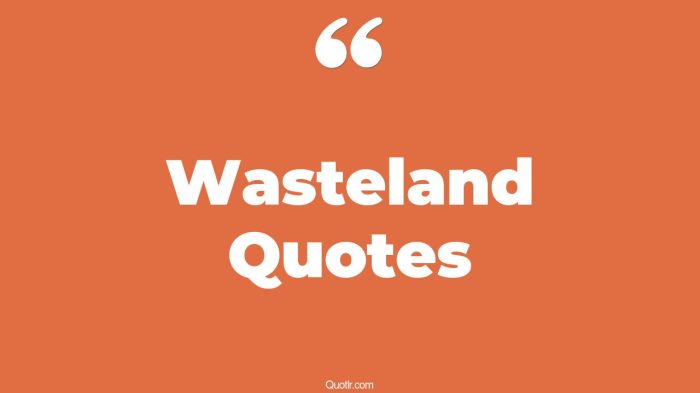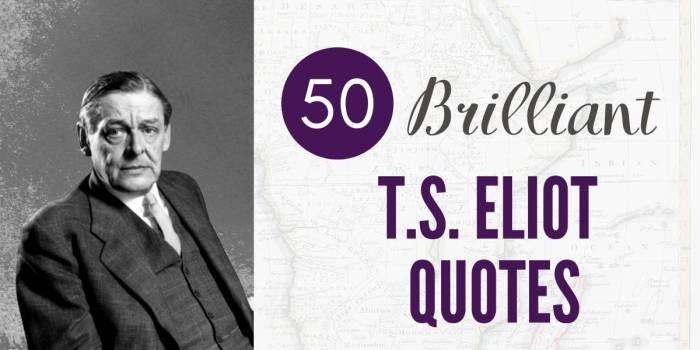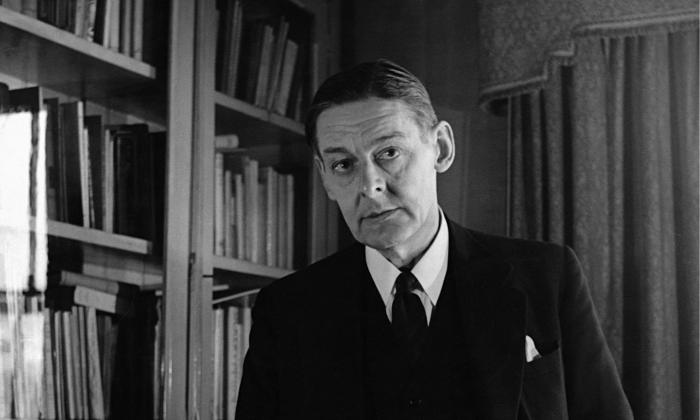Ts eliot the wasteland quotes – Embark on a literary journey with T.S. Eliot’s “The Waste Land” quotes, unlocking the profound insights and evocative imagery that have shaped modern literature.
This seminal poem, a mosaic of fragmented voices and allusions, confronts the disillusionment and alienation of the post-World War I era. Its haunting lines resonate with timeless truths, offering a poignant exploration of humanity’s search for meaning amidst the ruins of a shattered world.
T.S. Eliot’s “The Waste Land”

Overview
T.S. Eliot’s “The Waste Land” is a modernist poem published in 1922. It reflects the disillusionment and fragmentation that characterized post-World War I society.
Historical and Cultural Context
The poem emerged amidst the social, political, and cultural turmoil of the early 20th century. The horrors of the war had left a deep sense of loss and alienation, and traditional values and beliefs were crumbling.
Structure and Themes
“The Waste Land” is divided into five sections: “The Burial of the Dead,” “A Game of Chess,” “The Fire Sermon,” “Death by Water,” and “What the Thunder Said.” It explores themes of spiritual emptiness, the decay of civilization, and the search for meaning in a chaotic world.
Key Quotations from “The Waste Land”

T.S. Eliot’s “The Waste Land” is renowned for its intricate and evocative language, with numerous quotable lines that encapsulate the poem’s themes of fragmentation, alienation, and spiritual decay.
“April is the cruellest month, breedingLilacs out of the dead land, mixingMemory and desire, stirringDull roots with spring rain.”
This opening stanza sets the tone for the poem’s exploration of memory, loss, and the cyclical nature of time. April, typically associated with rebirth and renewal, is here portrayed as cruel because it evokes both the pain of the past and the unfulfilled desires of the present.
“I will show you fear in a handful of dust.”
This line, uttered by Tiresias, the blind prophet, encapsulates the poem’s sense of disillusionment and the futility of human existence. The “handful of dust” represents the fragility and insignificance of life, as well as the inevitability of death.
“The world is too much with us; late and soon,Getting and spending, we lay waste our powers.”
This quote critiques the materialistic and consumerist society that Eliot saw as spiritually bankrupt. It suggests that the relentless pursuit of material possessions leads to a loss of true meaning and purpose in life.
“These fragments I have shored against my ruins.”
This line appears at the end of the poem and serves as a summation of Eliot’s struggle to find meaning and order in a fragmented and chaotic world. It suggests that the fragments of memory, experience, and culture that he has collected can provide a semblance of solace amidst the ruins of his shattered world.
Literary Devices in “The Waste Land”: Ts Eliot The Wasteland Quotes

T.S. Eliot’s “The Waste Land” is renowned for its complex and evocative use of literary devices. Symbolism, imagery, and allusions intertwine to create a tapestry of meaning that explores the themes of loss, alienation, and spiritual emptiness.
Symbolism
Eliot employs a rich array of symbols to convey the poem’s themes. The wasteland itself represents the barrenness and decay of modern society, while the Fisher King symbolizes the impotent and wounded leader who presides over this desolate realm. Other symbols include the tarot cards, the Grail, and the hyacinth girl, each carrying specific associations that contribute to the poem’s overall meaning.
T.S. Eliot’s “The Waste Land” is a masterpiece of modernist poetry, renowned for its exploration of themes of fragmentation and despair. Its haunting imagery and allusions have resonated with readers for generations. However, even such a seminal work can be overshadowed by financial concerns.
Case in point: The Smiths took out a 130,000 loan, potentially distracting them from their artistic pursuits. Yet, despite the challenges of modern life, “The Waste Land” continues to inspire and provoke, reminding us of the enduring power of art.
Imagery
Eliot’s vivid and evocative imagery paints a vivid picture of the wasteland. The poem abounds with images of decay, fragmentation, and sterility, creating a sense of overwhelming despair and desolation. For example, the “dry stone” and “cactus land” convey a sense of aridity and barrenness, while the “broken images” and “ruined temples” symbolize the collapse of civilization.
Allusions
Eliot draws extensively on allusions to mythology, literature, and history to enrich the poem’s meaning. These allusions create a sense of intertextuality, connecting “The Waste Land” to a vast cultural heritage. For instance, the allusions to the Fisher King legend and the Grail quest evoke themes of spiritual longing and the search for redemption.
The combination of symbolism, imagery, and allusions in “The Waste Land” creates a multilayered and ambiguous work that invites multiple interpretations. These literary devices contribute to the poem’s evocative power, allowing it to explore the complexities of human experience and the challenges of modern life.
Themes in “The Waste Land”
T.S. Eliot’s “The Waste Land” is a modernist masterpiece that delves into the profound themes of alienation, fragmentation, and spiritual emptiness. Through its complex imagery and fragmented narrative, the poem reflects the disillusionment and despair that permeated society after the devastation of World War I.
Alienation and Fragmentation
One of the central themes of “The Waste Land” is the pervasive sense of alienation and fragmentation that afflicts the characters and the world they inhabit. The poem’s fragmented structure, with its shifting perspectives and abrupt transitions, mirrors the fragmented nature of modern society.
The characters in the poem are isolated and disconnected from each other, unable to communicate or form meaningful relationships. This is evident in the opening lines of the poem, which depict a barren and desolate landscape where “April is the cruellest month, breeding / Lilacs out of the dead land.”
The juxtaposition of the vibrant lilacs with the barren landscape highlights the contrast between the promise of life and the overwhelming sense of decay and emptiness.
The poem also explores the fragmentation of the self, as characters struggle to find meaning and purpose in their lives. The Fisher King, a central figure in the poem, is a symbol of this fragmentation. He is a once-powerful ruler who has been wounded and is now unable to fulfill his role as guardian of the land.
His wound represents the spiritual and psychological wounds that afflict the characters and the world around them.
Spiritual Emptiness
Another key theme in “The Waste Land” is the profound sense of spiritual emptiness that permeates the poem. The characters are disillusioned with the traditional values and beliefs that once gave meaning to their lives. They are left searching for something to fill the void, but their attempts are ultimately futile.
This spiritual emptiness is reflected in the poem’s imagery of decay and ruin. The “heap of broken images” in the opening lines represents the shattered fragments of the past that can no longer provide solace or meaning. The “Unreal City” of London is a symbol of the modern world, which is devoid of spirituality and purpose.
The poem also explores the search for redemption and renewal. The Fisher King’s wound can be seen as a symbol of the wounds that need to be healed in order for the land to be restored to its former glory.
The poem ends with a glimmer of hope, as the characters embark on a journey to find the Holy Grail, which represents the possibility of spiritual renewal.
Critical Reception of “The Waste Land”

Upon its publication in 1922, “The Waste Land” received mixed reviews. Some critics praised its innovative style and depth, while others found it晦涩难懂and disjointed. However, over time, the poem’s reputation has grown, and it is now widely regarded as one of the most important and influential works of modern literature.
Influence on Modern Literature and Culture, Ts eliot the wasteland quotes
“The Waste Land” has had a profound influence on modern literature and culture. Its fragmented structure, use of multiple voices, and exploration of themes such as alienation and despair have inspired countless writers and artists. The poem has also been adapted into operas, ballets, and films.
Modern Interpretations of “The Waste Land”

Contemporary readings of T.S. Eliot’s “The Waste Land” often focus on its relevance to modern society. The poem’s themes of alienation, fragmentation, and spiritual emptiness continue to resonate with readers in an era marked by technological advancements, globalization, and social upheaval.
Environmental Concerns
Modern interpretations of “The Waste Land” often emphasize its ecological dimensions. The poem’s depiction of a barren and desolate landscape reflects the growing awareness of environmental degradation and the need for sustainability.
Popular Questions
What is the significance of the title “The Waste Land”?
The title reflects the poem’s exploration of a barren and fragmented world, a wasteland devoid of spiritual and emotional sustenance.
How does Eliot use symbolism in “The Waste Land”?
Eliot employs a rich tapestry of symbols, such as the Fisher King, the Tarot cards, and the Grail, to convey the poem’s themes of alienation, spiritual emptiness, and the search for redemption.
What is the impact of “The Waste Land” on modern literature?
The poem’s innovative form and fragmented style influenced a generation of writers, shaping the course of modernist literature and challenging traditional poetic conventions.